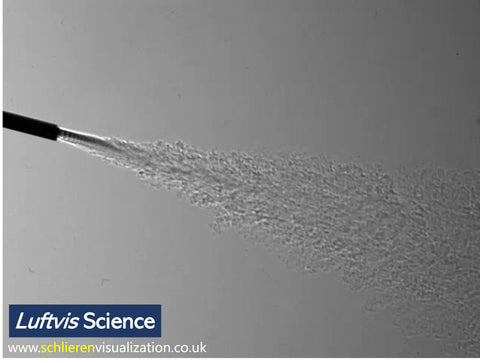Schlieren system can be realized through various light path setups, which offers different visualization outcomes. We will compare three commonly used light paths in this blog. Experiments on the mini-supersonic jet from the air duster have been performed against each schlieren light path, so that we can reveal the pros and cons.
Light Path 1 – Single-Mirror Off-Axis
This is the simplest light path as it only requires one concave schlieren mirror. It is important to ascertain the distance between the mirror and the pinhole of the illuminator to be double focal length (2f), which will deliver a good sensitivity of the schlieren system, as the small spot (image of the light emitter) to be ‘cut’ by the knife edge will be the smallest (same size as the LED).
The light cone from the LED illuminator does not overlap with the reflected one. There is a small angle between the center lines for each light cone. Later, we will realize that it is this small angle results in the shadow of the test flow, the major disadvantage of this light path.

Figure 1. The single-mirror off-axis light path schlieren system.
To do the schlieren experiment using light path 1, the test area is preferred to be in front of the schlieren mirror, as shown in figure 1. The schlieren image of the mini supersonic jet is revealed in figure 2. The jet is clearly visualized, so are the small turbulent structures. The supersonic core and shock waves are also revealed. However, it is interesting to find that jet also appears behind the long nozzle, as indicated by the arrow in figure 2. Is this part of the flow physical? As a matter of fact, this is the shadow of the jet. This phenomenon is due to the non-overlapping light cones. So far, we can realize that the single-mirror off-axis light path is easy to set up, however, the shadow of the air flow will show up in the schlieren image, which will affect the analysis of the flowfield.

Figure 2. Mini supersonic jet revealed by light-path 1
Light Path 2 – Single-Mirror Co-Axis
The second schlieren light path is an upgrade of the light path 1. It also makes use of one schlieren mirror, see figure 3. The present light path has an additional optical element, namely the beam splitter. Usually, a 50:50 split ratio is used. It is natural to appreciate the purpose of the beam splitter is to overlap the two light cones, so that the shadow of the test flow can be eliminated. The same mini supersonic jet visualized through light path 2 is shown in figure 4.

Figure 3. The single-mirror co-axis light path schlieren system.

Figure 4. Mini supersonic jet revealed by light-path 2
Obviously, the jet shadow is eliminated by using light path 2. However, there is a drawback of the current light path. Since the beam splitter only allows half of the light to pass, eventually only 25% of the light intensity from the LED can enter the camera. Therefore, the final schlieren image should be darker than that captured through light path 1.
To do a quick and short conclusion for light path 2: the addition of a 50:50 beam splitter could eliminate the flow field shadow, but the cost of the single mirror co-axis light path increases. The drawback is that a darker schlieren image will be resulted.
Light Path 3 – Dual-Mirror Z-Shaped Light Path
The last schlieren light path is the most frequently used for schlieren measurement. It is superior to the two light paths employing single schlieren mirror. The light path is folded and looks like the letter Z, this is the reason why people refer it to the Z-shaped light path. The greatest benefit of this light path is that the light beam passing through the test section is parallel, which prevents image distortion when passing through windows. This is why this light path is widely used in wind tunnel schlieren visualizations.

Figure 5. The dual-mirror Z-shaped light path schlieren system.

Figure 6. Mini supersonic jet revealed by light-path 3 with the Mach disks clearly visualized.
The resulted mini supersonic jet is shown in figure 6. Apart from the clear visualization of the turbulent jet, the Mach disk at the immediate outlet of the nozzle is also visualized, which is an important feature of supersonic jet flow. You may wonder why the Mach disks are not so sharply visualized in the other two lights involving only one mirror. It might be due to the fact that non-parallel light beams could affect the visualization outcome. As such, we can conclude that the dual-mirror Z-shaped light path offers superior visualization quality, but with increased cost (two schlieren mirrors are needed) and increased efforts in setting up the system (harder to align the light path).
Conclusion
Comparison of the above three schlieren light paths allows us to appreciate their pros and cons. We now can have the following conclusions:
| Single-Mirror Off-Axis | Single-Mirror Co-Axis | Dual-Mirror Z-Shaped | |
| Easy to Setup | 3 | 2 | 1 |
| Cost | 3 | 2 | 1 |
| Image Quality | 1 | 2 | 3 |
